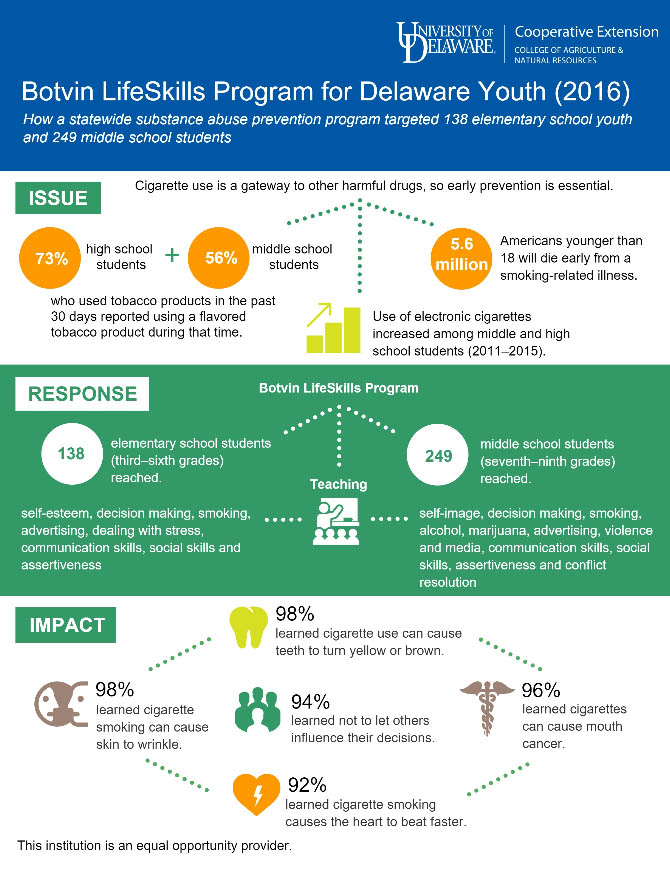
Botvin LifeSkills Program for Delaware Youth (2016)
- Health & Well-being
-
Agricultural Programs
- Agribusiness
- Animal Science
- Beginning Farmer Program
- Commercial Crops
- Commericial Horticulture
- Delaware Soil Testing Program
- Disease Management
- Farm Vitality and Health Project
- Irrigation
- Nutrient Management
-
Insect Pest Management
- Insect Trapping Program
- IPM Hot Topics
- Commercial Field Crop Insect Management
- Commercial Field Crop Disease Management
- Commercial Fruit & Vegetable Crop Pest Management
- EIPM Implementation Projects
- Pollinators
- Research and Extension Demonstration Results
- Brown Marmorated Stink Bug (BMSB) Management, Research, and Resources
- Publications
- Pesticide Safety Education Program
- UD Plant Diagnostic Clinic
- Variety Trials
- Weed Science
- Certified Crop Advisor Program
- Poultry Biosecurity
- 4-H
-
Horticulture
- Climate Variability and Change
- Delaware Soil Testing Program
- Forestry
- Lawn and Garden
- Master Gardeners
- Master Naturalist Program
-
Nutrient Management
- Nutrient Management Certification
- Continuing Education for Nutrient Management
- Nutrient Management Planning Resources
- Commercial Nutrient Handler Resources
- Poultry Litter and Manure Management
- Turf Management
- Agriculture Notebook
- Horticulture Handbook
- Agriculture & Horticulture Handbooks
- Crop Production
- Soil Fertility
- Delaware Climate Change Coordination Initiative (DECCCI)
- Salt Impacted Agricultural Lands

ISSUE
The Botvin LifeSkills Training, a research-validated substance abuse prevention program, was implemented to prevent cigarette use among Delaware youth, which is a potential gateway drug and can lead to the use of alcohol, marijuana and other harmful drugs. Vigorous youth education and the rising cost of tobacco products have caused a decline in youth and adult abuse. However, it still poses a threat, according to the U.S. Center for Disease Control and Prevention:
- If smoking continues at the current rate among youth in the U.S., 5.6 million of today’s Americans younger than 18 will die early from a smoking-related illness
- Nearly 9 out of 10 cigarette smokers first tried smoking by age 18; 99% first tried smoking by age 26
- Use of electronic cigarettes increased among middle and high school students from 2011 to 2015
- Scientific evidence shows that tobacco company advertising and promotion influence youth to start smoking
RESPONSE
The Botvin LifeSkills Program reached 138 elementary school students (third–sixth grades):
- In an afterschool program in a school setting (one site)
- In public school settings during school hours (four sites)
- At community centers (four sites)
Teachings included self-esteem, decision making, smoking, advertising, dealing with stress, communication skills, social skills and assertiveness.
The program reached 249 middle school students (seventh–ninth grades):
- In an afterschool program in a school setting (one site)
- In a public school setting during school hours (one site)
- In private school settings during school hours (eight sites)
- In community centers (four sites)
Teachings included self-image, decision making, smoking, alcohol, marijuana, advertising, violence and media, coping with anxiety and anger, communication skills, social skills, assertiveness and conflict resolution.
IMPACT
The post-test questionnaire summaries, prepared by National Health Promotion Associates. Inc., indicated that:
- 98% learned cigarette smoking can cause teeth to turn yellow or brown
- 98% learned cigarette smoking can cause skin to wrinkle
- 96% learned smoking cigarettes causes mouth cancer
- 92% of students learned cigarette smoking causes the heart to beat faster
- 94% of students learned not to let others influence their decisions
The University of Delaware is an Equal Opportunity Institution and Provider. Visit UD’s Office of Equity & Inclusion to learn more.
Additional Links
531 South College Avenue Newark, DE 19716 (302) 831-2501
